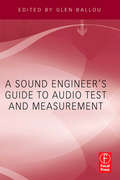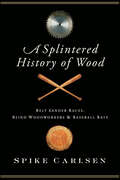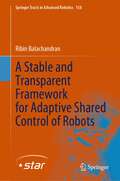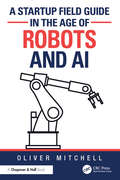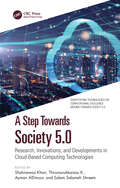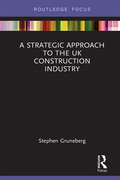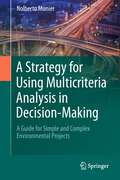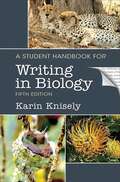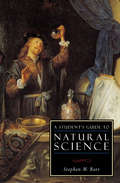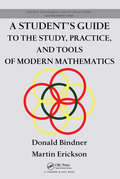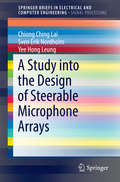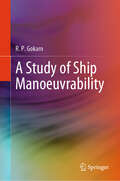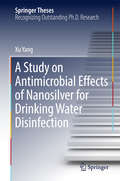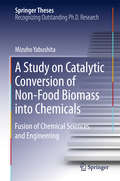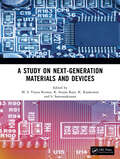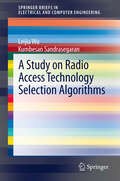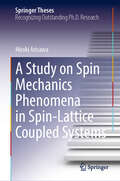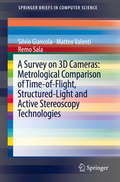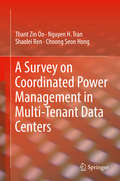- Table View
- List View
A Sound Engineers Guide to Audio Test and Measurement
by Glen BallouThis book offers a quick guide and complete reference to the fundamentals of test and measurement for all aspects of sound engineering.Including electrical and acoustic testing, measurement systems, levels, methods, protecting the ear, units of measurement and standards, this guide comes with and multiple tables to ensure quick easy access to information and illustrate points this is a must have reference for all audio engineers.
A Sourcebook for Environmental Education: A Practical Review Based on the Belgrade Charter
by W. Leal Filho Z. Murphy K. O'LoanThis is a comprehensive reference work, textbook, and sourcebook on the environmental education policies implemented in industrialized and developing nations since initiation of the benchmark UNEP-UNESCO International Environmental Education Programme at the Belgrade Workshop in 1975. The contributing authors cover both historical and international perspectives with particular reference to the 1992 debates in Rio. The book presents new information on areas for future action in teacher training, university-level environmental education for developing countries, and environmental education projects and networks for students and adults.
A Spitfire Girl: One of the World's Greatest Female ATA Ferry Pilots Tells Her Story
by Mary Ellis Melody ForemanWe visualize dashing and daring young men as the epitome of the pilots of the Second World War, yet amongst that elite corps was one person who flew no less than 400 Spitfires and seventy-six different types of aircraft and that person was Mary Wilkins. Her story is one of the most remarkable and endearing of the war, as this young woman, serving as a ferry pilot with the Air Transport Auxiliary, transported aircraft for the RAF, including fast fighter planes and huge four-engine bombers. On one occasion Mary delivered a Wellington bomber to an airfield, and as she climbed out of the aircraft the RAF ground crew ran over to her and demanded to know where the pilot was! Mary said simply: "I am the pilot!" Unconvinced the men searched the aircraft before they realized a young woman had indeed flown the bomber all by herself. After the war she accepted a secondment to the RAF, being chosen as one of the first pilots, and one of only three women, to take the controls of the new Meteor fast jet. By 1950 the farmer's daughter from Oxfordshire with a natural instinct to fly became Europe's first female air commandant. In this authorized biography the woman who says she kept in the background during her ATA years and left all the glamour of publicity to her colleagues, finally reveals all about her action-packed career which spans almost a century of aviation, and her love for the skies which, even in her nineties, never falters.
A Splintered History of Wood: Belt-Sander Races, Blind Woodworkers & Baseball Bats
by Spike CarlsenIn a world without wood, we might not be here at all. Without wood, we wouldn't have had the fire, heat, and shelter that allowed us to expand into the colder regions of the planet. If civilization somehow did develop, our daily lives still would be vastly different: there would be no violins, baseball bats, chopsticks, or wine corks. The book you are now holding wouldn't exist. At the same time, many of us are removed from the world where wood is shaped and celebrated every day. That world is inhabited by a unique assortment of eccentric craftsmen and passionate enthusiasts who have created some of the world's most beloved musical instruments, feared weapons, dazzling architecture, sacred relics, and bizarre forms of transportation. In A Splintered History of Wood, Spike Carlsen has uncovered the most outlandish characters and examples, from world-champion chainsaw carvers to blind woodworkers, the Miraculous Staircase to the Lindbergh kidnapping case, and many more, in a passionate and personal exploration of nature's greatest gift.
A Stable and Transparent Framework for Adaptive Shared Control of Robots (Springer Tracts in Advanced Robotics #158)
by Ribin BalachandranRobotic research and developments in computing technologies including artificial intelligence have led to significant improvements in autonomous capabilities of robots. Yet, human supervision is advisable and, in many cases, necessary when robots interact with real-world, outside-lab environments. This is due to the fact that complete autonomy in robots has not yet been achieved. When robots encounter challenges beyond their capabilities, a viable solution is to include human operators in the loop, who can support robots through teleoperation, taking complete control or shared control. This monograph focuses on a special form of shared control, namely mixed-initiative, where the final command to the robot is a weighted sum of the commands from the operator and the autonomous controller. The weights (fixed or adaptive), called authority allocation (AA) factors, decide who has more control authority over the robot. Several research groups use different methods to adapt the AA factors online and the benefits of adaptive mixed-initiative shared control have been well established in terms of task completion success and operator usability. However, stability of the overall shared control framework, with communication time-delays between the operator and the robot, is a field that has not been examined extensively. This monograph presents methods to improve performance and stability in shared control so that the possibilities of its applications can be widened. Firstly, methods to improve the haptic feedback performance of teleoperation are developed. Secondly, methods to stabilize adaptive shared control systems, while still ensuring high teleoperation performance, are proposed. The methods are validated on multiple robotic systems and they were applied in several projects, both in space and terrestrial domains. With the aforementioned contributions, this monograph provides an overarching framework to improve synergy between humans and robots. The flexibility of the framework allows integration of existent teleoperation and shared control approaches, which further promotes synergy within the robotics community.
A Startup Field Guide in the Age of Robots and AI
by Oliver MitchellLaunching a startup is like climbing a mountain, just maybe more treacherous. I say this as I have spent years as a backpacker and entrepreneur. While hiking through the Alaskan Tundra, I feared brown bears and crevasses. Yet, nothing prepared me for the responsibility of payroll for over 200 families relying on my business plan to feed their children.Unlike traditional software, the mere smell of hardware sensors and robot gearing sends shivers through most investors, with red flags arising from the perceived capital inefficiencies and intense research and development. This is coupled with a high talent requirement before launching even a minimum viable product, as these inventions demand a cross-section of skills: mechanical, electrical, and software engineering. To set out on the trail of uncrewed success, machine inventors and founders require a detailed field guide to meet customer demand and financing objectives.My goal for this book is to help you at a pivotal point in your ideation process and, at the same time, introduce you to a cadre of potential mentors. Through interviews with some of the most respected luminaries in this field, I aim to help fortify your resolve to follow your passions and build a billion-dollar company. The chapters of this book have been organized like a field guide, as if you are setting out on a trip in the wild. Just like it’s essential to satiate yourself before scaling mountains, fast-tracking your innovation into the hands of early adopters is vital for achieving success on Main Street.
A Step Towards Society 5.0: Research, Innovations, and Developments in Cloud-Based Computing Technologies (Demystifying Technologies for Computational Excellence)
by Shahnawaz KhanThis book serves the need for developing an insight and understanding of the cutting-edge innovation in Cloud technology. It provides an understanding of cutting-edge innovations, paradigms, and security by using real-life applications, case studies, and examples. This book provides a holistic view of cloud technology theories, practices, and future applications with real-life examples. It comprehensively explains cloud technology, design principles, development trends, maintaining state-of-the-art cloud computing and software services. It describes how cloud technology can transform the operating contexts of business enterprises. It exemplifies the potential of cloud computing for next-generation computational excellence and the role it plays as a key driver for the 4th industrial revolution in Industrial Engineering and a key driver for manufacturing industries. Researchers, academicians, postgraduates, and industry specialists will find this book of interest.
A Strategic Approach to the UK Construction Industry
by Stephen GrunebergThe construction industry is a microcosm of the economy as a whole, and as such the economics of the sector contains many of the aspects of the economy in general, albeit with fascinating and unique features. What are the implications of economic theory for the future of UK construction? How does the industry ensure innovation, quality and efficiency? What priorities might best serve the construction industry, those working in it and their customers? In seeking answers to these and other questions, the UK government has commissioned a number of reports on the construction industry including the Latham and Egan reports and more recently Construction 2025. These have invariably proposed time and cost targets for the construction industry. In this new book, Stephen Gruneberg stands in stark contrast to those reports and presents the relevant theoretical aspects of construction economics to account for the behaviour of construction firms and suggest a strategy for future growth and sustainability. He discusses the theory and data relating to the output of firms in relation to the type of firm, the market and how these firms behave as a result. The purpose of this book is to advocate the measures needed to create the kind of industry that must be fostered to ensure the quality of its output, sustainability and the fair terms and conditions of employment for its workforce. Gruneberg’s new book is essential reading for anyone wishing to understand the economic forces that determine industry outcomes and who has a stake in the success of the UK construction sector.
A Strategy for Active Remote Sensing Amid Increased Demand for Radio Spectrum
by Committee on a Survey of the Active Sensing Uses of the Radio SpectrumActive remote sensing is the principal tool used to study and to predict short- and long-term changes in the environment of Earth - the atmosphere, the oceans and the land surfaces - as well as the near space environment of Earth. All of these measurements are essential to understanding terrestrial weather, climate change, space weather hazards, and threats from asteroids. Active remote sensing measurements are of inestimable benefit to society, as we pursue the development of a technological civilization that is economically viable, and seek to maintain the quality of our life. A Strategy for Active Remote Sensing Amid Increased Demand for Spectrum describes the threats, both current and future, to the effective use of the electromagnetic spectrum required for active remote sensing. This report offers specific recommendations for protecting and making effective use of the spectrum required for active remote sensing.
A Strategy for Using Multicriteria Analysis in Decision-Making: A Guide for Simple and Complex Environmental Projects
by Nolberto MunierThis book develops a whole strategy for decision-making, with the full participation of the decision-maker and utilizing continuous feedback. It introduces the use of the very well-known and proven methodology, linear programming, but specially adapted for this purpose. For this, it incorporates a method to include subjective concepts, as well as the possibility of working with many different and even contradictory objectives. The book is liberally populated with diverse case studies to illustrate the concepts. This practical guide will be of interest to anyone undertaking analysis and decision-making, on both simple and complex projects, and who is looking for a strategy to organize, classify, and evaluate the large amount of information required to make an informed decision. The strategy includes methods to analyze the results and extract conclusions from them.
A Student Handbook for Writing in Biology
by Karin KniselyA Student Handbook for Writing in Biology, Fifth Edition, provides practical advice to students who are learning to write according to the conventions in biology. The first chapter introduces the scientific method and experimental design. Because the scientific method relies on the work of other scientists, Chapter 2 provides instructions for finding primary literature using article databases and scholarly search engines. Journal articles have a well-defined structure, but are typically hard to read because they are written for specialists. To help students read and comprehend the technical literature, Chapter 3 describes scientific paper tone and format, provides strategies for reading technical material, emphasizes the importance of paraphrasing when taking notes, and gives examples of how to present and cite information to avoid plagiarism. Using the standards of journal publication as a model, students are then given specific instructions for writing their own laboratory reports with accepted format and content, self-evaluating drafts, and using peer and instructor feedback to refine their writing. Besides writing about it, scientists communicate scientific knowledge through posters and oral presentations. How these presentation forms differ from papers in terms of purpose, content, and delivery is the subject of the last two chapters of the book. <p><p>Scientific communication requires more than excellent writing skills--it requires technical competence on the computer. Most first-year students have had little experience producing Greek letters and mathematical symbols, sub- and superscripted characters, graphs, tables, and equations. Yet these are characteristics of scientific papers that require a familiarity with the computer beyond basic keyboarding skills. Furthermore, most first-year students are used to doing calculations on a handheld calculator. When they learn how to use Excel's formulas to do repetitive calculations, their time spent on data analysis decreases markedly. For exactly these reasons, almost half of the book is devoted to Microsoft Word, Excel, and PowerPoint features that enable scientists to produce professional quality papers, graphs, posters, and oral presentations effectively and efficiently.
A Student's Guide to Data and Error Analysis
by Herman J. C. BerendsenAll students taking laboratory courses within the physical sciences and engineering will benefit from this 2011 book, whilst researchers will find it an invaluable reference. This concise, practical guide brings the reader up-to-speed on the proper handling and presentation of scientific data and its inaccuracies. It covers all the vital topics with practical guidelines, computer programs (in Python), and recipes for handling experimental errors and reporting experimental data. In addition to the essentials, it also provides further background material for advanced readers who want to understand how the methods work. Plenty of examples, exercises and solutions are provided to aid and test understanding, whilst useful data, tables and formulas are compiled in a handy section for easy reference.
A Student's Guide to Natural Science (ISI Guides to the Major Disciplines #8)
by Stephen M. BarrA concise introduction to scientific history and ideas, with a special emphasis on physics and astronomy. Physicist Stephen M. Barr&’s lucid Student&’s Guide to Natural Science aims to give students an understanding, in broad outline, of the nature, history, and great ideas of natural science from ancient times to the present, with a primary focus on physics. Barr begins with the contributions of the ancient Greeks, in particular the two great ideas that reality can be understood by the systematic use of reason and that phenomena have natural explanations. He goes on to discuss, among other things, the medieval roots of the scientific revolution of the seventeenth century, the role played by religion in fostering the idea of a lawful natural order, and the major breakthroughs of modern physics, including how many newer &“revolutionary&” theories are in fact related to much older ones. Throughout this thoughtful guide, Barr draws his readers&’ attention to the larger themes and trends of scientific history, including the increasing unification and &“mathematization&” of our view of the physical world that has resulted in the laws of nature appearing more and more as forming a single harmonious mathematical edifice.
A Student's Guide to the Study, Practice, and Tools of Modern Mathematics (Discrete Mathematics and Its Applications)
by Martin Erickson Donald BindnerA Student's Guide to the Study, Practice, and Tools of Modern Mathematics provides an accessible introduction to the world of mathematics. It offers tips on how to study and write mathematics as well as how to use various mathematical tools, from LaTeX and Beamer to Mathematica and Maple to MATLAB and R. Along with a color insert, the text include
A Study into the Design of Steerable Microphone Arrays (SpringerBriefs in Electrical and Computer Engineering)
by Chiong Ching Lai Sven Erik Nordholm Yee Hong LeungThe book covers the design formulations for broadband beamformer targeting nearfield and farfield sources. The book content includes background information on the acoustic environment, including propagation medium, the array geometries, signal models and basic beamformer designs. Subsequently it introduces design formulation for nearfield, farfield and mixed nearfield-farfield beamformers and extends the design formulation into electronically steerable beamformers. In addition, a robust formulation is introduced for all the designs mentioned.
A Study of Ship Manoeuvrability
by R. P. GokarnThis book presents various aspects of Ship Manoeuvrability in a form that can be understood without undue effort. Beginning with the equations of motion, the book describes the main manoeuvring mathematical models with their application in the numerical simulation of various manoeuvres. The other topics covered in the book range from manoeuvring model tests and full-scale trials through rudder hydrodynamics and design to manoeuvring standards and guidelines. This book also discusses ship autopilots and dynamic positioning. Finally, it provides a description of unconventional rudders and propulsion devices used for manoeuvring. The book has more than 180 figures to explain various concepts and 40 exercises with partial solutions to confirm that the reader has understood the subject. The book also includes recent developments in the subject and can be a valuable reference for beginners, researchers, and professionals interested in the field.
A Study of the Fukushima Daiichi Nuclear Accident Process: What caused the core melt and hydrogen explosion?
by Michio IshikawaWritten by an expert in the field, this book is perfect for those who would like to know what happened at the Fukushima Daiichi Nuclear Power Plant. Part 1 of the book studies how core melts occurred in Fukushima Daiichi units 1, 2, and 3, respectively, based on evidence from the Three-Mile Island core melt accident and fuel behavior experiments performed in the 1970s under the cooperation between the United States, Germany, and Japan. This information explains the accident processes without contradicting data from Fukushima, which was published in the TEPCO report. The hydrogen explosions in units 1, 3, and 4 are also explained logically in conjunction with the above core melt process. Part 2 clarifies how the background radiation level of the site doubled: The first rise was just a leak from small openings in units 1 and 3 associated with fire-pump connection work. The second rise led to direct radioactive material release from unit 2. Evacuation dose adequacy and its timing are discussed with reference to the accident process, and the necessity for embankments surrounding nuclear power plants to increase protection against natural disasters is also discussed. New proposals for safety design and emergency preparedness are suggested based on lessons learned from the accident as well as from new experiences. Finally, a concept for decommissioning the Fukushima site and a recovery plan are introduced.
A Study on Antimicrobial Effects of Nanosilver for Drinking Water Disinfection (Springer Theses)
by Xu YangThis thesis examines the feasibility of using silver nanoparticles (AgNPs) as a viable disinfectant. It explores the opportunities and challenges of using AgNPs as an antimicrobial agent, and includes the latest research findings. It compares three kinds of AgNPs with regard to their antibacterial and antiviral effects; their sustainability in real water matrices; and their antiviral mechanisms. The outcome of this research equips the water industry with a better understanding of the capacity, extent and mechanisms of nanosilver disinfection. It is of interest to graduate students, academics and researchers in the area of nanotechnology and environmental engineering.
A Study on Catalytic Conversion of Non-Food Biomass into Chemicals: Fusion of Chemical Sciences and Engineering (Springer Theses)
by Mizuho YabushitaThe topic of this thesis is catalytic conversion ofnon-food, abundant, and renewable biomass such as cellulose and chitin tochemicals. In biorefinery, chemical transformation of polymers to valuablecompounds has attracted worldwide interest for building sustainable societies. First, the current situation of this hot research area has been summarized wellin the general introduction of the thesis, which helps readers to becomefamiliar with this topic. Next, the author explains high-yielding production ofglucose from cellulose by using an alkali-activated carbon as a catalyst,resulting in a yield of glucose as high as 88%, which is one of the highestyields ever reported. The characterization of carbon materials has indicatedthat weak acid sites on the catalyst promote the reaction, which is markedlydifferent from reported catalytic systems that require strong acids. Inaddition, the first catalytic transformation of chitin with retention of N-acetyl groups has been developed. Thecombination of mechanocatalytic hydrolysis and thermal solvolysis enables theproduction of N-acetylated monomers ingood yields of up to 70%. The catalytic systems demonstrated in this thesis areunique in the fields of both chemistry and chemical engineering, and their highefficiencies can contribute to green and sustainable chemistry in the future. Meanwhile, mechanistic studies based on characterization, thermodynamics,kinetics, and model reactions have also been performed to reveal the roles ofcatalysts during the reactions. The results will be helpful for readers todesign and develop new catalysts and reaction systems.
A Study on Next-Generation Materials and Devices
by K. Srujan Raju M. S. Vijaya Kumar K. Rajakumar S. SaravanakumarA Study on Next-Generation Materials and Devices proudly presents the proceedings of the International Conference on Next-Generation Materials and Devices (ICNMD, 2024) held from August 01–03, 2024, in Virudhunagar, India. ICNMD 2024 served as a crucial platform, focusing on state-of-the-art research and development in A Study on Next-Generation Materials and Devices for sustainable development. The diverse program explored major topics such as energy solutions, environmental concerns, advanced sensors, the role of artificial intelligence, and computational approaches for materials design. It also delved into biomaterials for medical applications, alongside discussions on next-generation semiconductors, and flexible electronics poised to revolutionize the electronics industry. The event covered all the significant verticals related to materials and devices, featuring pioneers who shed light on uncharted domains.
A Study on Radio Access Technology Selection Algorithms (SpringerBriefs in Electrical and Computer Engineering)
by Leijia Wu Kumbesan SandrasegaranThis book discusses the basic idea of Common Radio Resource Management (CRRM), especially on the Radio Access Technologies selection part of CRRM. It introduces two interaction functions (information reporting function and RRM decision support function) and four interaction degrees (from low to very high) of CRRM. Four possible CRRM topologies (CRRM server, integrated CRRM, Hierarchical CRRM, and CRRM in user terminals) are described. The book presents different Radio Access Technologies selection algorithms, including single criterion and multiple criteria based algorithms are presented and compares them. Finally, the book analyses the advantages and disadvantages of the different selection algorithms.
A Study on Spin Mechanics Phenomena in Spin-Lattice Coupled Systems (Springer Theses)
by Hiroki ArisawaThis book presents an experimental investigation of spin-mechanical phenomena in spin-lattice coupled systems. The author demonstrates that the resonant mechanical vibration of a micro magnetic mechanical oscillator changes in response to the magnetization process in the oscillator. The author also investigates a spin-current-induced volume modulation effect in a giant magnetostrictive material. The results presented here accelerate the exploration of cross-correlation effects between spintronics and micromechanics and provide insight into magnetomechanical properties associated with a spin current.
A Summer of Horses
by Carol FennerTen-year-old Faith struggles to overcome her fear of horses and her feelings of jealousy toward her talented older sister when they spend the summer on a horse farm.
A Survey on 3D Cameras: Metrological Comparison of Time-of-Flight, Structured-Light and Active Stereoscopy Technologies (SpringerBriefs in Computer Science)
by Silvio Giancola Matteo Valenti Remo SalaThis book is a valuable resource to deeply understand the technology used in 3D cameras. In this book, the authors summarize and compare the specifications of the main 3D cameras available in the mass market. The authors present a deep metrological analysis of the main camera based on the three main technologies: Time-of-Flight, Structured-Light and Active Stereoscopy, and provide qualitative results for any user to understand the underlying technology within 3D camera, as well as practical guidance on how to get the most of them for a given application.
A Survey on Coordinated Power Management in Multi-Tenant Data Centers
by Thant Zin Oo Nguyen H. Tran Shaolei Ren Choong Seon HongThis book investigates the coordinated power management of multi-tenant data centers that account for a large portion of the data center industry. The authors include discussion of their quick growth and their electricity consumption, which has huge economic and environmental impacts. This book covers the various coordinated management solutions in the existing literature focusing on efficiency, sustainability, and demand response aspects. First, the authors provide a background on the multi-tenant data center covering the stake holders, components, power infrastructure, and energy usage. Then, each power management mechanism is described in terms of motivation, problem formulation, challenges and solution.
